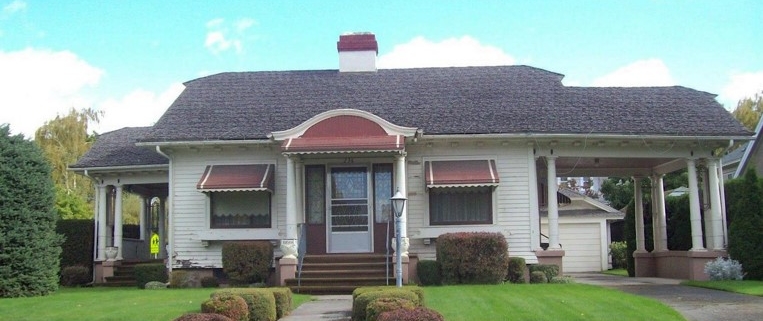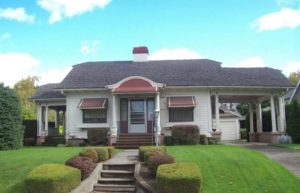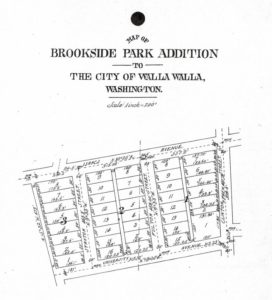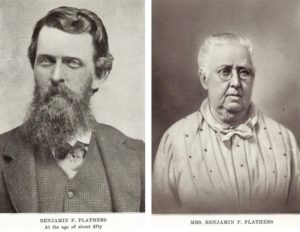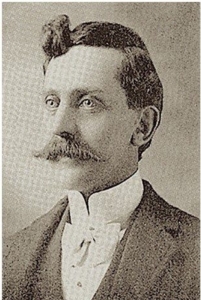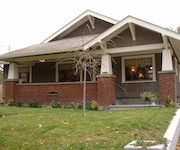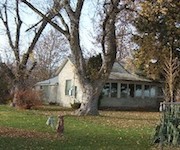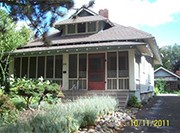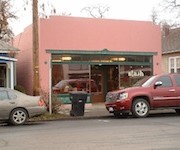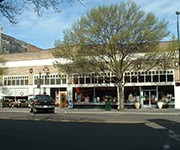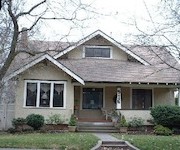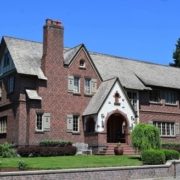History of 236 Stanton Street – Walla Walla, WA
Legal Description
All of Lot 9 and that part of Lot 10 lying Northerly of a line drawn parallel to and distant 25 feet Southerly at right angles from the Northerly line of said Lot 10, all in Block 2 of Brookside Park Addition to the City of Walla Walla, according to the official plat thereof of record in the Office of the Auditor of Walla Walla County, Washington, in Book “C” of Plats at Page 52.
Title and Occupant History
Washington Territory was created in 1853. In 1854, the new territorial legislature created Walla Walla County, which stretched from the crest of the Cascade Mountains to the crest of the Rocky Mountains in the present states of Washington, Idaho and Montana. In 1855, Isaac Stevens, governor of Washington Territory, held a council on the banks of Mill Creek at the present site of Walla Walla with representatives of regional Indian tribes to purchase land from them. The Yakamas, Cayuses and Walla Wallas were dissatisfied with the treaties and the intrusion by whites into their lands before the treaties’ ratification, and war followed. Missionaries, former French-Canadian employees of the Hudson Bay Company trading post at Wallula, and soldiers at the military Fort Walla Walla were the primary European occupants of the area prior to 1859, when the treaties were finally ratified, and the land was opened for settlement. The transfer of ownership occurred by virtue of a treaty signed on June 9, 1855, in Walla Walla and ratified on March 8, 1859 by President James Buchanan, in which all of the land in the Walla Walla area was acquired from the Cayuse and Walla Walla Indian tribes.
The town of Walla Walla was originally laid out by County Surveyor Hamet Hubbard Case in 1859, prior to its formal incorporation as a city in 1862, as a one-quarter mile square with its eastern side centered on the point where Main Street crossed Mill Creek (at roughly the point where it does now). The original plat was lost, probably in the fire of 1865. Thus, the earliest plat on file is one made by W. W. Johnson, City Surveyor, in July 1865 that claims to have made corrections to Case’s survey. Johnson’s survey was made the official plat of the City of Walla Walla on September 25, 1866, was filed and recorded July 5, 1867.
To this original area, additional parcels were annexed from time to time, usually with the name of the landowner of record at the time the additions were made. 236 Stanton Street is on land originally owned by Henry P. Isaacs, who has his name attached to many additions near this address; however, it was his widow, Lucie Isaacs, who developed this area and named it Brookside Park Addition. The Isaacs’ home is located nearby at 100 Brookside Drive. On the 1905 Sanborn Fire Map an alley parallel to and east of Stanton Street was also named Brookside Way. The brook referenced is College Creek.
The first recorded transaction involving 236 Stanton Street was on May 23, 1863, when John Haley sold a portion of the SW 1/4 of section 21 in Township 7, County of Walla Walla, Washington Territory consisting of approximately 26 acres to William H. Patten and Elizabeth Patten. The nominal recorded price was $100. On January 20, 1864, the Pattens sold this parcel along with other land in Section 20 to Isaacs for $2000 in gold coin, creating an 80-acre piece which took in most of what are now the residential areas to the east and north of Whitman College. Isaacs played an important role in the development of agriculture in Walla Walla. According to Lyman’s History of Walla Walla County, he was among the first to suggest that the hills around Walla Walla would be better used for growing wheat rather than simply grazing livestock on the existing bunchgrass. Wheat growing led to Isaacs’ development of several flour mills in Walla Walla and the Northwest, among them the Excelsior Flour Mill located on this 80-acre parcel. He also found markets for wheat in the Orient, especially China, beginning that important trade for this area.
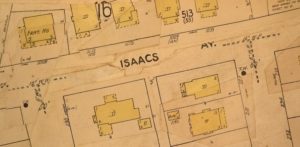
The 1905 Sanborn Fire Insurance Map showing updates of January 1923. 236 Stanton Street is at the lower left. Stanton Street is the vertical street on the left and Fulton Street on the right.
4/20/1864, Warranty Deed, William H. and Elizabeth A. Patten, grantors; H. P. Isaacs, grantee, 80 acres “beginning at the S.W. Corner of the N.W. Quarter of the S.W. Quarter of Section 21 in Township 7 North of Range 36 East, run[ning] thence East 80 rods, thence North 135 ½ feet, thence West 81° South 118 and 88/100ths rods, thence on a straight line to the place of beginning. Containing 80 acres, and to be the same as contained in said boundary more or less in Section 20 and 21 North of Range 36 East, Township 7. To have and to hold said premises unto the said H. P. Isaacs, his heirs and assigns forever that said premises are free from all incumbrances [sic] except four acres sold and conveyed to the said H. P. Isaacs at a former time but included in this conveyance and that [the Pattens] will warrant and forever defend said premises (with the above exception) unto the said H. P. Isaacs, his heirs and assigns against the lawful claim of all others,” $2,000.
4/5/1866, Warranty Deed, William H. and Elizabeth A. Patten, grantors; Henry P. Isaacs, grantee, 80 acres, $2,000.
9/22/1881, Lease, H. P. and Lucie Isaacs, grantors; J. C. Isaacs, grantee, 80 acres Sections 20 and 21, including water rights to supply the City of Walla Walla, to build and maintain ditches, to construct and maintain a building to enclose an existing reservoir; a 25-year lease for $10,000.
9/11/1886, Right of Way Deed, J. C. Isaacs to The Walla Walla Water Company, a Corporation, see description in above lease, $1 and other valuable considerations.
6/27/1894, Quit Claim Deed, Lucie Isaacs, grantor; Henry P. Isaacs, grantee, including the 80 acres in Sections 20 and 21, $1.
3/28/1896, Warranty Deed, Henry P. and Lucie Isaacs, grantors; Miles C. Moore, W. W. Baker and H. C. Baker, Trustees, grantees, multiple properties including the location of Pacific [Flouring] Mill (now Wildwood Park) and Mill Race, $20,000.
4/10/1896, Warranty Deed, see above warranty deed, to “grant, bargain, sell and convey unto the parties of the second part and to their heirs and assign forever…” $20,000.
9/2/1898, Warranty Deed, Z. M. Beebe, J. C. Taylor, E. S. Isaacs, Emma E. Shaw and Anna H. Leuders, Trustees of the Odd Fellows Home of the State of Washington, grantors; H. P. Isaacs, grantee, 6 ¾ acres more or less…lying between the north bank of Mill Creek and the south side of Boyer or Fraternity Avenue. “This deed is made and intended to correct an error in description in that certain deed dated the 25th day of September 1896 [not included among the deeds for either Lot 9 or that portion of Lot 10 in Block 2 that define the location of 236 Stanton Street], and for no other purpose. And all freehold interests were conveyed by said deed,” $1.
12/2/1899, Warranty Deed Against Grantors, W. W. Baker, H. C. Baker and Miles C. Moore, Trustees, grantors; The City of Walla Walla, a Municipal Corporation, grantee, including properties in Sections 21, 22 and 23, $1.
8/22/1901, Deed, A. J. Patten, et al, grantors; Heirs of H. P. Isaacs, grantees, “to correct an error in said description in [Deed of 4/5/1866] by the scrivener…”
6/5/1903, Quit Claim Deed, The Right Worthy Grand Lodge of the Independent Order of Odd Fellows of the State of Washington, grantor; Lucie Isaacs, a widow, Bessie I. Savage, Charlotte M. Doneny, Edwin S. Isaacs, Grace G. Isaacs and J. P. Isaacs, heirs at law of Henry P. Isaacs, deceased, grantees, 6 7/8 acres more or less lying between the north bank of Mill Creek and the south side of Boyer or Fraternity Avenue, $1. In 1905, Lucie Isaacs, widow of H. P. Isaacs, had a portion of her property surveyed and platted for residential building lots named Brookside Park Addition. It was approved by the Walla Walla City Council, signed on October 31, 1905 and filed January 5, 1906. The addition was comprised of three blocks. Block 1 contained 15 lots, Block 2 16 lots and Block 3 just eight lots. In that Block 3 was located on the west side of Stanton Street, those lots were acquired by Whitman College and became the site of Lyman House residential dormitory.
11/11/1911, Indenture, Lucie Isaacs, a widow, grantor; John H. Morrow, grantee, Lots 10 and 11, Block 2 of Brookside Park Addition, $3,400. John Morrow owned Morrow-Drew Hardware Company. He and his wife, Emma, resided at 208 Stanton Street.
5/17/1921, Statutory Warranty Deed, J. H. and Emma C. Morrow, grantors; John T. Flathers, grantee, Lot 9 and the north ½ of Lot 10, Block 2, $1 and other valuable considerations.
5/5/1925, Administrator’s Deed, Union Trust Company of Walla Walla, Washington, a Corporation, acting Administrator of the estate of John T. Flathers, deceased, grantor; Sim J. and Etta M. Culley, grantees, Lot 9 and the north ½ of Lot 10, Block 2, $8,626. Sim Culley was listed in city directories as a farmer. He and his wife, Etta, resided at 10, 20 Park Street.
5/26/1926, Affidavit, W. W. Baker to The Public, stating that he was present when Henry and Lucie Isaacs conveyed to Miles C. Moore, W. W. Baker and H. C. Baker certain properties by Deed on 12/1/1899, that they acted merely as Trustees, that the Walla Walla Water Company conveyed $5,000 with a balance of $15,000 advanced as a loan from the estate of Dorsey S. Baker.
6/4/1963, Executor’s Deed, Maxine Culley Wood AKA Maxine M. Wood, executrix of the Last Will and Testament of Etta M. Culley, deceased, and Robert V. Wood, as executor of same, grantors; William and Eva Pearl Luchte, grantees, Lot 9 and the north 25 feet of Lot 10, $10 and other valuable considerations.
11/13/1989, Statutory Warranty Deed, John Reese as personal representative of the estate of Eva Pearl Luchte, deceased (William Luchte deceased 1978), grantor; Vicki L. Bates, a single person, Lot 9 and the north 25 feet of Lot 10, $10 and other valuable considerations. Vicki Bates was listed in city directories as retired.
3/20/2013, Warranty Deed, Vicki L. Bates, grantor; Robert Collins, grantee, Lot 9 and north 25 feet of Lot 10, Block 2, $200,000.
2/7/2018, Quit Claim Deed, Robert Collins, grantor; Laura Lee Kerwin, grantee.
1/20/2022, Statutory Warranty Deed, Randall L. and Laura Lee Kerwin grantors; Julia and Randy Long, grantees.
Construction of Building
A native of Louisville, KY, Benjamin Flathers was raised in Iowa. He traveled to New York City in 1859 from where he sailed around the Horn, bound for San Francisco. There he ran a pack train along the coast until around 1861 when he transferred his business to The Dalles. He arrived in Walla Walla around 1869 where soon he met and married a young widow, Malinda Harris. The widow Harris had crossed the plains in a wagon with her late husband and two young boys. En route, her husband and one son died.
Flathers acquired property in the Prescott area where he and Malinda established the Mullan Road Halfway House near the town of Prescott. There they provided services for persons traversing the Mullan Road. It was called Halfway House because it was approximately midpoint between Fort Walla Walla and the Snake River crossing at Lyons Ferry.
The Mullan Road was the first engineered wagon road in the Northwest, begun in 1859 under the direction of Lt. John Mullan. It stretched from Fort Walla Walla to Fort Benton, Montana, eventually connecting the Columbia River to the Missouri River by incorporating an earlier road between Walla Walla and Wallula. (See Walla Walla 2020’s signage for the Mullan Road at North 13th Avenue and Abadie Street.)
Benjamin and Malinda had six children, the eldest being the above-mentioned Julia (1869-1960) and the second eldest John Flathers (1870-1925). All six were raised and attended school in a one-room schoolhouse on the ranch. After years of being a successful farmer, Benjamin Flathers retired in 1907 and built a fine house in Walla Walla, extant at 644 Boyer Avenue. It is minimally classical inspired, of brick and masonry construction, and was built by C. B. Lambert and J. A. Bailey. Neither man was listed under Architects in the 1907 city directory, But Swedish-born Charles Lambert was indeed an architect, trained in his native country. He arrived in Walla Walla in 1898 where he maintained an architectural practice, residing in a house he designed and presumably built himself, extant at 609 East Alder Street. Julia Flathers never married and lived in her parents’ Boyer house. The elder Flathers died in 1910 (Benjamin) and 1917 (Malinda) respectively. Julia was still residing in the house at the time of the 1940 census, where she housed two boarders.
John T. Flathers remained in the Prescott area and partnered in farming with two of his brothers, Edwin and Charles. He married Harriet (Hattie) Frances Brown on January 9, 1912. Julia Flathers, living in Walla Walla by that time, was a member of First Congregational Church, whose minister, the Rev. Dr. Raymond C. Brooks, officiated, though it is unknown whether the marriage took place at that church. Dr. Brooks was also on the faculty of Whitman College.
It could not be determined if, and if so how many, children John and Hattie had, but as did his parents earlier, John eventually retired from farming and moved to Walla Walla. The Flathers hired Walla Walla’s most prominent architect, Henry Osterman, at that time in partnership with the young architect Victor Siebert, to design a house for them.
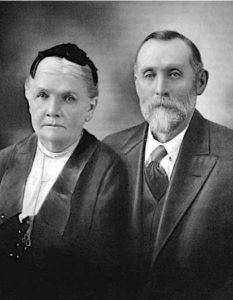
This photo appears to be John T. and Hattie Flathers most likely shortly before they died. Identification is not positive, but Mr. Flathers’ heavy eyelids and aquiline nose match those of the photo of the young John Flathers.
Henry Osterman was born near Essen, Germany in 1862. Having received some architectural training in Dusseldorf, Germany, he and his three brothers left for the United States in 1889, settling in Walla Walla where they worked as carpenters. By 1892, his three brothers had returned to Germany. Having begun his career here as a carpenter, in 1899 Osterman began advertising himself as an architect, although it was not until 1919, by then a very successful architect, that he received his architectural license.
Walla Walla native Victor E. Siebert began working for Osterman at age 18 as a draftsman. He went east to complete his education at Boston Technical School, eventually returning to his hometown where he formed a partnership with Osterman in 1912. The partnership remained until Osterman retired and moved to Seattle in 1927.
Building Permit 3362 was granted to John Flathers on 7/28/1921 to construct a house on the corner of Stanton Street and Isaacs Avenue. The house was estimated to cost $8,000 and a fee of $5 was assessed by the city for the permit. Nick Wierk was listed as contractor. (The permit listed directly above the one for Flathers also listed Wierk as contractor for that project, although the penciled handwriting and spelling of his surname was impossible to decipher. Luckily the name was found in the monthly column Progress Notes in an issue of Up-To-The-Times so the correct spelling could be determined.) Nick Wierk was not listed in any city directories of the time under the categories for contractors or carpenters, and his alphabetical listing did not specify an occupation. The 1921-22 city directory listed John and Hattie Flathers’ residence as 713 Isaacs Avenue; the 1923-24 directory listed them at 236 Stanton Street. If construction commenced shortly after the building permit was issued, it is possible that the house could have been completed by the end of 1921 but based on city directory listings it is more likely that the completion date was 1922.
236 Stanton Street is a one and one-half story bungalow that could be described as having both Craftsman and Colonial Revival characteristics. While the symmetrical main façade faces Stanton Street, a second entrance is located on the Isaacs side. That porch is somewhat larger than the front porch, and the current owners feel that being on the north (cool) side of the house, and with a more spacious side yard at greater distance from Isaacs Avenue, much less traveled than it is today, the porch would have been a wonderful place to sit and relax on a hot summer evening.
The roof is side-gabled, moderately pitched, with a secondary side-gable projecting over the Isaacs entry. The roof over the Stanton front porch is a segmented arch, initially specified to have a tin roof, and there is a substantial porte-cochère on the right side also with a gabled roof; a third entrance to the house is from the porte-cochère. All gable ends are canted.
Clusters of slightly tapered columns without capitals support the porches and the porte-cochère. Siding is clapboards. Osterman’s plans show dormers with segmented arched roofs that were to be tinned projecting from the main gable; it is not known if they were not built or perhaps removed at some point.
John Flathers was not able to enjoy his new city home very long. He died January 19, 1925 at just 54 years of age. Hattie predeceased him in 1924 at just 50 years old. For reasons unknown, both are buried in the City Cemetery in Waitsburg. Several Flathers are buried in Prescott’s Ivy Cemetery.
References
- TitleOne Title & Escrow (formerly Pioneer Title) Whitman Archives
- Walla Walla City Directories, various years Walla Walla County Auditor online deed search City of Walla Walla plat map
- Andres, Penny, Walla Walla: Her Historic Homes, Vol. 1, 1991
- Lyman, William D., Lyman’s History of Old Walla Walla County, Vols. 1 and 2, S. J. Clarke, Chicago, 1918 Mullen Road History website, compiled by Walla Walla 2020
- First Congregational Church History, 1910
- John T. and Harriet (Hattie) Flathers marriage certificate Ivy Cemetery, Prescott, burial records
- City Cemetery, Waitsburg, burial records United States Census records for 1940

